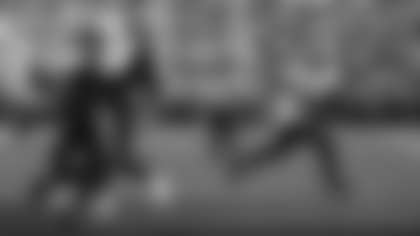In sifting through the e-mail from the last few days, I came across an unusually high volume of questions I had answered in previous columns (see the bottom of this column for a few examples).
Now, that's not a problem. I understand that there are many people out there who have not read all, or even most, of my previous work here on Buccaneers.com. When possible, I post the repeats and direct the fans to the original answer.
Still, this got me to thinking. This is, amazingly, the 30th Answer Man column since my debut during last year's training camp. No one thought I would have this sort of lasting power…I guess I showed all those teams that passed on me during draft day. I'll make them all pay. (Sorry, I think I've read too many post-draft interviews.)
Anyway, I had an idea. What is this idea of which I speak? Let me tell you.
I thought I would go back through the last 29 columns and pull out a few of the more interesting topics we discussed in order to make a little Answer Man Review Quiz. I'll remind you of seven previous fan questions in a series of multiple-choice questions. You identify which are the right answers. The answer key is at the very end of this column.
There is nothing to win here, besides the satisfaction you get from knowing that you have one of the great football minds of our land. And, yes, this is the second quiz-centric opening in the last two columns…I'm not in a rut, I'm just feeling professorial. Attention, class!
So let's take the Answer Man Review Quiz!
- (From Volume 11.) What happens if a pass hits the crossbar and is caught by an offensive player in the end zone? * a. It is a touchdown. * b. It is a touchback. * c. It is a 10-yard penalty against the offense and no score. * d. It is a dead ball. * e. The referee immediately stops the game and awards the receiver a Dodge Durango.2. (From Volume 4.) What do the terms "one-technique" and "three-technique" mean in reference to defensive tackles? * a. One-technique is a one-point stance used by an under tackle and three-technique is a two-point stance used by a nose tackle. * b. One-technique is more of a high-energy gap player and three-technique is more of a nose-tackle type. * c. One-technique players shoot the one-gap (between the center and guard) while three-technique players shoot the three-gap (between the tackle and tight end). * d. One-technique players focus on one specific task each play while three-technique players rotate between three concepts. * e. Nothing. It's fake terminology meant to make the game seem more confusing to the average fan.3. (From Volume 14.) What would the Answer Man's passer rating be if he subbed in for the Bucs for one play, took a snap, dropped back seven steps, rolled away (screaming) towards the sideline and, in a panic just before he ran out of bounds, threw a ball downfield and three rows up into the stands? * a. 0.0 * b. 21.4 * c. 39.6 * d. 50.8 * e. Ryan Leaf4. (From Series 2, Volume 1.) Why does a receiver sometimes point to the sideline shortly before the ball is snapped? * a. He's calling for a sub on the next play. * b. He's checking with the line judge to make sure he's lined up correctly. * c. He's alerting the quarterback as to the direction he's going to run on an option route. * d. He's telling the head coach that he has heard the audible. * e. He's alerting the ball boy that he forgot his Sharpie.5. (From Volume 5.) When do NFL Europe roster exemptions expire? * a. At the beginning of training camp. * b. At the mandatory NFL roster cutdown to 65 players. * c. At the final roster cutdown to 53 players. * d. At the trade deadline. * e. When Euro-Disney closes.6. (From Volume 19.) Why are some timeouts in the NFL identified as "30-second timeouts?" * a. Each team has two standard timeouts and one 30-second timeout. * b. The play-clock begins at 30 seconds, rather than 45 seconds, after a 30-second timeout. * c. All timeouts in the final two minutes of play are 30-second timeouts. * d. After all of the network commercial breaks have been satisfied, remaining timeouts do not break away from the broadcast. * e. One-minute timeouts seemed excessive.7. (From Volume 22) At the line of scrimmage, what is a possible tip-off that the quarterback intends to throw a pass on that play? * a. He blinks rapidly before the snap. * b. He licks his fingers. * c. He wipes his hands on his pants. * d. He glances at the wide receivers. * e. He conducts an elaborate Swahili ritual at the line of scrimmage designed to bless an airborne pigskin spheroid.Now on to this week's questions...
**
Richard Schilling of Breinigsville, Pennsylvania asks:
Let's talk loose balls and infinite planes. We all know that if a player dives from the 2 yard line and crosses the plane of the goal line outside the pylon before touching the ground out of bounds, it is a touchdown because the goal line is considered to extend indefinitely past the sideline. Does this apply to loose balls, specifically a fumble and a punt? If a runner fumbles at the two (or a punt bounces at the two) and the ball travels in the air across the goal line outside the pylon before touching the ground, is it a touchback or is it down at the point it crossed the sideline in the air? (Imagine Freddy Mitchell's fumble - against Atlanta, I think - in which he reached out for the end zone and fumbled before crossing it, giving the opponents a touchback. If he had reached outside the pylon and fumbled, would it be a touchback or fumble out of bounds?)
Answer Man: If you reviewed some of those old columns in the course of taking that quiz, you probably saw Richard's name pop up here and there. I think he's the leader in the clubhouse in terms of questions making it into my columns. Yes, he's greasing me under the table.
Anyway, Richard has proved to know his football, but I don't think any of us are going to be over the confusion of this whole goal-line plane thing any time soon. Specifically, I take issue with his description of the player scoring a touchdown after diving out of bounds.
Part of the confusion probably stems from Rule 11, Section 2, Article 1, which states (in part):
It is a touchdown: (a) when a runner advances from the field of play and ball touches the opponents' goal line (plane); or...
Think about what that parenthetical "plane" means in the phrase above. The rule says the ball has to touch the goal line, but how many touchdowns occur when the ball actually makes physical contact with the painted line on the field? Most of the time, the ball is somewhere above the line, in the hands of the scoring player. In this case, the word "plane" describes the goal line vertically. The ball doesn't have to actually touch the painted line, it just has to cross the vertical plane defined by that line.
The problem is, there is also the concept of the plane of the goal line extending indefinitely beyond the sidelines...that is, horizontally. I think that perhaps we get these two concepts confused.
This horizontal plane is important, too. If a player crosses the goal line with the ball, and the ball is also across the goal line but it is horizontally out of bounds, it is still a touchdown. Imagine a player diving towards the left pylon; he touches the pylon with his right hand and has the ball in his left hand as far forward as his right hand. That would be a touchdown. In a Monday Night Football game at St. Louis on November 26, 2001, RB Warrick Dunn dived near the goal line and most of his body was out of bounds, though it hadn't touched the ground yet. His left foot hit the pylon, however, and the ball was already across the goal line, so that was ruled a touchdown. By touching the pylon, he established himself inbounds right at the goal line. Had he never touched anything but the out-of-bounds area, the ball would have been spotted where he dived out of bounds.
Rule 11, Section 2, Article 1 does not mean that the goal line extends indefinitely horizontally for a player out of bounds. If you jump out of bounds at the two-yard line and proceed diagonally through the air three yards wide of the sideline, and never again touch the pylon or any part of the field, you will be called out of bounds at the two.
So it's basically the same concept for a loose ball. If it bounces out of bounds at the two and flies through the air across the horizontal plane of the goal line without touching the ground, that is not a touchback. Furthermore, it would remain in possession of the offensive team. Rule 7, Section 5, Article 6 states:
A fumble that goes forward and out of bounds is to return to that team at the spot of the fumble.
Freddie Mitchell's fumble came out of his hands and stayed inbound as it crossed the goal line, then went out of the end zone. That's a touchback. Had his fumble come out of his hand at an angle and gone out of bounds before hitting the goal line, the Eagles would have retained possession no matter where the ball went after it went out of bounds.
**
- Chris Smith of Tampa, Florida:
Dear All-Powerful Mighty Answer Man, I know the NFL Draft is right around the corner in April and I have a question. First of all, just to let you know, I am unfortunately the brother of the guy who you questioned the lucidity of as you talked about kicker footballs back in Series 2, Volume 6. Anyways, on to football. My first general question is how can a team who's supposed to pick at 7, actually pick at 9? This happened during the 2003 NFL draft when Minnesota apparently didn't get their selection to the podium in time and subsequently their time ran out. So Jacksonville and Carolina quickly got their selections out before Minnesota (one of them being Byron Leftwich). My question is, was that fair? Are there any rules on the NFL Draft for such a case like this? Are there any other interesting and weird rules for the NFL Draft that are worth noting? Also, when a team makes a decision on who they want to select, who from the team announces their selection, and who do they give their selection to? In other words, can you tell me the process that is followed from the moment a team decides their guy to the time the NFL commissioner reads the selection on the podium? Then I will better understand what is going on behind the scenes when the 2005 Draft starts. Thanks Answer God.
Answer Man: Whew! Did everybody get all of that?
Actually, this was my favorite question of the week, because it gained momentum as it went and eventually got to the most interesting topic at the end.
Starting at the top, I think you answered your own question as to how a team slated to pick at number 7 could actually pick 9 (of course, another way would be to trade, right?). As you noted, the Vikings did not get their card to the podium within the allotted 15 minutes. When that happens, the clock starts on the next team in order, and it can make its pick as soon as it wishes, even if that is before the original team picks. If that team picks and the original team still has not made its selection, then the following team's 15 minutes start and it can pick at any time. The original team can pick at any point, too, and end all the madness.
Yes, it was fair and specifically provided for in the rules, which is why the results stood. In that case, Jacksonville took Leftwich, the Panthers jumped in with T Jordan Gross and the Vikings eventually nabbed DL Kevin Williams. At the time, all three teams claimed to have gotten the players they wanted, and it's certainly hard to argue with the results. All three have proved to be outstanding players; Williams was in the Pro Bowl this year and the other two appear to have some trips to Hawaii in their futures.
The rules for the situation are exactly as described above. If your allotted time runs out, the time begins for the next team and either team can now pick, first come, first served.
Now, on to the machinations by which the name formed in the mind of a general manager winds up coming out of the mouth of the commissioner, or other NFL employee, at the podium in New York.
While all 32 teams have representatives who gather at draft headquarters in New York, the real work is done in "war rooms" at the teams' respective headquarters. In those draft rooms, teams have a phone line (or two) that is kept open during the entire draft and connects to the team's table in New York. There are usually at least two team representatives at this table, and their job is simple but incredibly important: Write the correct name down on the card and hand it to the NFL rep.
See, all that matters, in the end, is the name on that card. If the person on the phone at team headquarters says, "Mark White, DT" and the person on the other end in New York hears, "Mike White, OT," there is trouble ahead. Whatever player the person in New York hands in will be the one drafted. There are rumors of this happening once or twice, but nothing I can substantiate. To combat this, the people in the draft room usually have the person on the other end of the line repeat the pick several times.
**
- "Waiting in Florida" asks:
Oh Answer Man, you tease. Please, please, don't leave me unsatisfied! I am sitting here anxious and hopeful. Please, I must know, what is a cast card? Oh thank you, Answer man! I knew you would do it if I asked just right. How was that? Yep, that should do it.
Answer Man: The Answer Man doesn't usually like to include questions without real names attached, but "Waiting" was the only reader to take the bait on the cast card question (so far).
The cast card, which is filled out by the team's trainer (if necessary), lists all the players who will be competing in the game with some sort of cast or other artificial device protecting an injury. For instance, a defensive back might play despite having a broken wrist, usually wearing a cast and some sort of protective plastic sheet over the cast. The officials need to be aware of this, so they do not think the player is wearing illegal equipment.
**
- Larry Harmon of Bradenton, Florida asks:
I saw someone say the NFL salary cap is over with in 2 more years. Is that true? Also: How far over the salary cap are the tampa bay bucs.
Answer Man: Incredibly, that could be true, Larry. I say "could" because, of course, there will be some effort between now and then to work out a new agreement similar to the existing one, which has worked so well in the NFL. But, yes, at the moment, the 2007 season is slated to be "uncapped."
That means exactly what it sounds like: A team could spend as much money as it wishes on player salaries that year. In fact, if a team wanted to gamble, it could actually begin factoring that uncapped year in right now. For example, Team A could sign QB John Doe to a three-year contract that pays him $5 million in 2005, $5 million in 2006 and $25 million in 2007.
Like I said, that would be a gamble, because if a salary cap was worked out for the 2007 season, then that $25 million would be a problem.
As to your second question, Larry, the answer is: Not at all. The Buccaneers are not currently over the salary cap, as that would be a major violation with big repercussions. The salary cap is a 365-days-of-the-year thing, which means a team must always stay underneath or risk being fined.
Of course, what you are referring to is, how far would the Bucs be over the cap when the 2005 league season starts on March 2 if they kept all of their current contracts? In other words, if you add up all the salaries that the current player contracts that have 2005 seasons, do you come up with a number that is over the $85.5 million cap for '05, and if so, by how much?
Unfortunately, I am not at liberty to provide that answer. However, the important thing to know is that the Bucs will NOT be over the cap when March 2 rolls around, nor will any other team in the NFL. If there is excessive salary, it will have to be trimmed one way or another.
**
- Martin Breen of Gansevoort, New York asks:
Dear Answer man, Do you know what dates the Bucs will be playing in Foxboro and the Meadowlands in the 2005-2006 season?
…and Kristina Armstrong of Port Charlotte, Florida asks:
When is the 2005 season schedule coming out?
Answer Man: Martin, I think you'll see the answer to your question in what I tell Kristina.
The schedule for the 2005 season will likely come out in the last few days of March or the first few weeks of April. Let's see, going back over the last five years, the NFL schedule was released between March 28 and April 14 each spring. It was the day before Tax Day last year, but April 3 in 2003, March 28 in 2002, April 12 in 2001 and April 4 in 2000.
The NFL usually lets a few interesting notes about the schedule leak a couple days before releasing the full deal, such as the first Monday Night Football game of the year. When you see those notes, you'll know the schedule is about to hit; here at Buccaneers.com, we'll have the news up as soon as it's released.
So, you see, Martin. I can't answer your question just yet. The Bucs will have road games against the Pats and the Jets next fall, but we'll have to wait another five or six weeks to know the exact dates.
**
- Stephen Mezzapelle of Spring Hill, Florida asks:
Hey Answer Man, I would like to know how many former players that went to other teams, went to the Hall of Fame after leaving the BUCS?
Answer Man: One assumes this question was prompted by the recent selection of QB Steve Young for the Pro Football Hall of Fame. Young, as most Buc fans know, got his NFL start in Tampa in 1985, after playing several lucrative but ultimately fruitless seasons in the short-lived USFL. Young was a supplemental draft pick of the Buccaneers in 1984 and he began play in the NFL in Tampa in 1985. After two seasons with the Buccaneers, he was traded to San Francisco where, of course, he went on to his greatest glory.
Young is the only such player, though, Stephen. He now joins DE Lee Roy Selmon as the only two men in the Hall who played for the Buccaneers. As we discussed in Volume 11, a player is not required to "choose" a team to represent in the Hall; rather the whole of his career is considered as his qualifications and displayed on his plaque. Players are represented by busts, which do not include helmets.
As a fan pointed out after our initial discussion of this matter, Hall of Fame T Anthony Munoz was also briefly with the Buccaneers during the 1992 preseason. However, Munoz was injured during the second game that August, thus ending his career. Because he didn't appear on the Bucs' regular-season roster, he is not affiliated with the Bucs in the Hall of Fame.
**
- Trevor of Tampa, Florida asks:
Thank you for running such a great and entertaining service! I am currently going to college for business and am looking to get into the football industry in a front office kind of way. I was curious as to any suggestions you may have for accomplishing this? What kind of experience is recommended for most paid entry-level jobs?
Answer Man: Well, it depends somewhat on what specific department you're trying to break into, Trevor, but in general it's a good idea to work in whatever is the college analog of the job you want in the pros. That is, if you want to do public relations for an NFL team, get a job in the sports information department at your school. If you want to be a trainer for a pro team, be a trainer for your college teams.
You specifically mention paid, entry-level jobs, but you might want to consider starting with an internship if you can't immediately land the position you want. In NFL public relations, as an example, many of the full-time professionals were originally interns with that team or another team.
**
- Fran of Waldorf, Maryland asks:
I was recently looking at some really old football cards of the Bucs and I saw that there were three letters (I think) on the sleeve of the jerseys of the players. Can you tell me what I saw. I could have been mistaken. Thanks a lot AM
Answer Man: Not having access to the same cards, I'll have to guess, Fran, but I think you're probably referring to the 1993 season. (And it hurts the Answer Man that you consider cards from that year "really old.") I've looked back through some older photos of the '70s and '80s and not found a patch or insignia that fits your description.
In 1993, the Buccaneers' sleeves were adorned with "Mr. C," which referred to the team's late original owner, Hugh Culverhouse.
**
- Paul of Ft. Lauderdale, Florida asks:
**In the modern age of football where stats are everything please answer this for me. Why does a QB get charged for an interception if the ball is tipped by the receiver? It doesn't seem fair.
Keep up the good work.**
Answer Man: Well, no offense Paul, but what are you going to call it? It's clearly a turnover, and it's not a fumble, so it has to be an interception. And it wasn't the receiver who threw the ball.
Listen, I get your point. There are interceptions that are not the quarterback's fault, and they are not limited to the plays where the ball bounces out of a receiver's hands into those of a defender. There are instances where a receiver runs the wrong route and is thus not where he is supposed to be when the pass arrives, allowing the ball to go straight to a defender.
It seems unfair that the quarterback is the one charged with the negative statistic when the turnover was really someone else's fault. But that is the nature of individual statistics in a team game, and to take your approach and absolve the QB in this situation would be to open Pandora's Box.
The center and the right guard allow two defensive tackles to instantly penetrate the backfield on a running play and nail the runner as soon as he receives the handoff. Why should the running back be credited with a two-yard loss when it was clearly not his fault?
Two plays later, the same back goes the wrong way in the pass-protection scheme and fails to block a blitzing linebacker, resulting in a sack. At the end of the season, the offensive line will be judged on the team's sacks-allowed total, and that one will definitely count. Is that fair?
It's the same in any team sport, really. If a defenseman in hockey allows a puck to go off his skate and into his own goal, his goalie is still going to take a hit on his goals-against total. If a point guard makes a perfect pass in basketball but the forward blows an easy lay up, bye bye assist. A slow-footed shortstop could cost a groundball pitcher several hits a game.
Stats are what they are, Paul. You have to score the game some way or another. You have to trust that it works out in the end. In other words, most quarterbacks are going to fall victim to the tipped-pass interception at one point or another during the season. A great QB will still keep his pick total low, while a lesser passer will turn it over often.
**
- Dave Y. Tweedy of Watertown, New York asks:
Dear Mr. A-Man, I read the column this week. Good stuff as usual...very "ah, now I understand..." kinda-stuff, you know? So my question to you is this...you said the Bucs would make the playoffs, and that was the easiest question of the year. But based on our cap situation, our need for beef on the O-line, and a 12-20 record the last 2 years, how can that be the easiest question? Now a cop-out answer is to say, "I am a fan." But you can do better and maybe explain your prediction based on some logic, some gameplan so to speak. So? Why will they EASILY make the playoff last year? Thanks A-Man (not to be mistaken for A-Train).
Answer Man: Dave, what you call a "cop-out," I call a "joke."
Now, before you jump on that, let me explain that I do not think it is a joke that the Bucs could make the playoffs last year. Rather, the implicit joke in my brief answer – actually, in even choosing to include that question at all – is that the Answer Man, being an unshakably loyal employee/fan, would never hesitate to say that, yes, he thinks the Bucs will be in the playoffs next year.
Not an overwhelmingly funny joke, admittedly, but a rather obvious one, I think. Also, you could say that it was the easiest answer so far for me because it was just one three-letter word. As you may have noticed, I have a problem with verbosity.
Still, your question was nicely worded and I can tell you would really like an answer...so here comes the real cop-out, and it comes in two fabulous parts. One, it wouldn't make much sense to break down the roster now, as it is likely to undergo some significant changes through free agency and the draft. Two, as it states on my introduction/question submission page, those types of predictions are not meant to be my bailiwick. To wit:
"Please note: Players and coaches are free to answer their questions as they see fit, but the Answer Man is here to offer factual information. I will not be sharing opinions on why the team signed or released a certain player, or predictions on how well a specific player may do this season, or any other topic that is basically a matter of opinion."
Thus, the joke was even including that question, when it's not one I'm really supposed to take on. I thought it would reinforce my (deserved) reputation as a unflinching Buccaneer optimist, but perhaps I should have just skipped it.
(But I still think we're going to the playoffs!)
**
Asked and Answered
Here are a handful of recent questions that we've already discussed in previous columns.
- Don Jackson of Nashville, Tennessee asks:
We all know one of the luxuries of playing for the Bucs and living in Florida is no state income tax. Since, on average, half their salary is "earned" out of state, do pro football players pay state income taxes to other states?
Answer Man: Short answer: Yes. A slightly more detailed discussion can be found in Volume 20.
**
- Jon Randall of Cocoa, Florida asks:
Dear Answer Man, I wanted to know what does it mean when a team says there going to apply the "franchise" tag to a certain player?
Answer Man: We covered this one at some length in Series 2, Vol. 2 (and a subsequent jump to Volume 22). In short, a franchise tag prevents a pending free agent from signing with other teams, but it also compels a team to pay that free agent at a rate commensurate with the highest-paid players in the league at that position.
**
That's it for now. The Answer Man intended for this to be another "mini-column;" 10 pages later, I'm still not through the questions in the queue. For those wondering if their submissions were going to make it into the column, here are a few topics you'll see in the next volume: Buccaneer color codes, practice squad Super Bowl rings, Sean Farrell and Captain Fear's tan, or the lack thereof.
That's right, Captain Fear's tan. Stay tuned.
**
Quiz Answers
- d 2. b 3. c 4. b 5. c 6. d 7. b
If you guessed (e) to any question, your Answer Man reading privileges are hereby revoked.




































